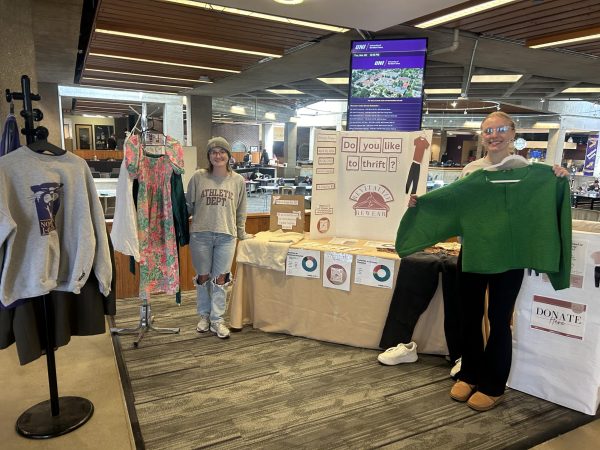Art Dept. lecture covers feminist art
Feb 17, 2020
At 6 p.m. on Tuesday, Feb. 11, Dr. Claire Kovacs presented a lecture titled “The SisterSerpents’ Rage + Bodily Autonomy” in Kamerick Art Building. A crowd of students, faculty and community members were in attendance as Kovacs not only detailed the history of the collective, but also explained the groups and movements which informed and continued themes of the SisterSerpents’ work.
Dr. Elizabeth Sutton, an art historian, curator and professor in UNI’s Department of Art, introduced Kovacs to the stage. Sutton explained how she has known Kovacs for fifteen years, projecting a slide of photos of the two from years past. Sutton also talked briefly about “Empowered,” the show she co-curated that is currently on display in the UNI Gallery of Art.
“Whereas I used to think feminism and anti-racism could be embedded within my scholarship and pedagogy, many events in the last ten years have galvanized me to be explicit about power structures, and to own and use my own privileges in ways that are explicit, reflective and supportive. And maybe that’s maturity; fifteen years or more will do that,” Sutton said. “The ‘Empowered’ show is a reflection of some of my thoughts about that, and […] I think being able to bring a friend and colleague to campus is empowering for me, for her and I hope also for our students.”
Kovacs, who works as Curator of Collections and Exhibitions at Binghamton University, used quotes from her research to spin the tale of the SisterSerpents, which began with a classified ad that founding member Jeramy Turner ran in a Chicago newspaper. The group, which according to Kovacs aimed to “utilize art as a weapon of social change,” held their first meeting on July 4, 1989, on the day following the Supreme Court’s controversial Webster v. Reproductive Health Services ruling. The ruling raised concerns about womens’ reproductive health rights, a theme that became prevalent in the SisterSerpents’ anonymous artistic work in the years to follow.
“From this small generation, the SisterSerpents’ ranks grew, as did their practice and praxis,” Kovacs said. “Calling it ‘pestering,’ they combatted misogyny and the patriarchy through curatorial work, performances, lectures, letters to the press, a zine […] called ‘Mad Women’ and guerilla tactics, including posters and neon stickers on ads, lamp posts and the walls of Chicago.”
Kovacs then projected and read from the SisterSerpents’ manifesto.
“Our art is merely and marvelously our weapon,” she read.
The SisterSerpents used their anonymous platform to combat misogyny and anti-abortion movements through public art campaigns. One of the more visible of these campaigns was their 1990 billboard “Your Message Here” on Chicago’s Randolph Street It featured images of white clothes hangers against a black background, asking viewers the question of what reproductive healthcare would look like in the 1990s.
Kovacs connected the SerpentSisters’ work to different feminist public artworks through contemporary times. Two groups originating in Berlin, the November Group and the Berlin Dadaists, were cited as major influences on the SisterSerpents’ art and philosophies. Kovacs profiled these historical groups and provided examples of specific artists and how their work informed the SisterSerpents.
A common misconception about the SisterSerpents, one that Kovacs admitted to having at first about the group, is that they drew inspiration from the Guerilla Girls, an anonymous feminist art collective founded in New York City in 1985. Kovacs explained that her research proved otherwise; the Guerilla Girls’ aim was to combat misogyny in the art world, while the SerpentSisters were against misogyny and anti-abortion movements in society as a whole.
“And that’s where my research stands,” Kovacs concluded, describing her research on the SerpentSisters as “an excavation” of this anonymous guerilla movement and its motivations, inspirations and influence.
At the end of the lecture, Kovacs opened the floor to audience questions, which included queries about toxic masculinity, white feminism and Kovacs’ personal connection and journey with this research.
Sam Barnhart, a senior pursuing his BFA in studio art, said that Kovacs’ lecture reflected subjects that had been on his mind.
“I just think it’s really important stuff,” Barnhart said. “I think it’s something I’ve been thinking about lately, about being angry about things and about the situation that we’re in [with] oppressors of women, of people of color, of certain sexual identities. It’s okay to be mad about it and it’s okay to be mad about it in a way that’s creative and positive. I think that’s something that’s been pushed forward in this presentation; I think that’s something cool, to be validated in your anger.”













